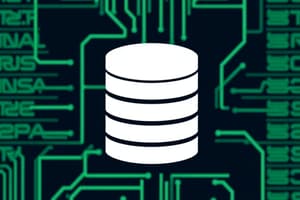Podcast
Questions and Answers
Which of the following are types of databases mentioned?
Which of the following are types of databases mentioned?
- Multimedia Databases (correct)
- Geographic Information Systems (GIS) (correct)
- Text Documents
- Social Networks
A database is defined as a collection of unrelated data.
A database is defined as a collection of unrelated data.
False (B)
What does DBMS stand for?
What does DBMS stand for?
Database Management System
A __________ is a software package/system to facilitate the creation and maintenance of a computerized database.
A __________ is a software package/system to facilitate the creation and maintenance of a computerized database.
Which applications interact with a database?
Which applications interact with a database?
Name one recent application of databases.
Name one recent application of databases.
Active processing in a DBMS may take internal actions on data.
Active processing in a DBMS may take internal actions on data.
What is a mini-world in the context of databases?
What is a mini-world in the context of databases?
Flashcards
Database
Database
A structured collection of related data.
DBMS
DBMS
Software that manages and manipulates databases.
Data
Data
Known facts with inherent meaning.
Mini-world
Mini-world
Signup and view all the flashcards
Database System
Database System
Signup and view all the flashcards
Multimedia Databases
Multimedia Databases
Signup and view all the flashcards
GIS
GIS
Signup and view all the flashcards
Data Warehouses
Data Warehouses
Signup and view all the flashcards
Querying
Querying
Signup and view all the flashcards
Transactions
Transactions
Signup and view all the flashcards
Security
Security
Signup and view all the flashcards
Retrieval
Retrieval
Signup and view all the flashcards
Modification
Modification
Signup and view all the flashcards
Database Design
Database Design
Signup and view all the flashcards
Conceptual Data Model
Conceptual Data Model
Signup and view all the flashcards
Application Activities
Application Activities
Signup and view all the flashcards
Real-time Databases
Real-time Databases
Signup and view all the flashcards
Mobile Databases
Mobile Databases
Signup and view all the flashcards
Data Types
Data Types
Signup and view all the flashcards
Database Environment
Database Environment
Signup and view all the flashcards
Study Notes
Course Information
- CS 215: Fundamentals Of Database Systems
- Lecturer: Mohamed Ghoneimy
- Copyright © 2016, 2011, 2007 Pearson Education, Inc.
- Textbook: Fundamentals of Database Systems, Seventh Edition
Database Types
- Traditional Applications: Numeric and Textual Databases
- Recent Applications:
- Multimedia Databases
- Geographic Information Systems (GIS)
- Biological and Genome Databases
- Data Warehouses
- Mobile databases
- Real-time and Active Databases
Recent Developments
- Social Networks: Facebook, Twitter, LinkedIn
- Search Engines: Google, Bing, Yahoo
Basic Definitions
- Database: Collection of related data
- Data: Known facts with implicit meaning
- Mini-world: Part of the real world represented in a database
- Database Management System (DBMS): Software for creating and maintaining a computerized database
- Database System: DBMS software, data, and sometimes applications
Impact of Databases
- Businesses: Banking, Insurance, Retail, Transportation, Healthcare, Manufacturing
- Service Industries: Financial, Real-estate, Legal, Electronic Commerce, Small businesses
- Education: Resources for content and delivery
- Social Networks: Sharing information and communications
- Environmental and Scientific Applications: Research and analysis
- Medicine and Genetics: Medical records, research
- Personalized Applications: Smart mobile devices
Database System Environment
- Users interact with applications that access the database through a Database Management System (DBMS).
DBMS Functionality
- Define the database: Data types, structures, and constraints
- Construct and load initial database contents
- Manipulate the database:
- Retrieval: Querying, generating reports
- Modification: Insertions, deletions, and updates
- Accessing the database through web applications
- Manage concurrent users and applications while ensuring data validity and consistency
Application Activities
- Applications interact with the database through queries and transactions
- Queries access data and formulate results
- Transactions read data, update values, or generate new data
- Applications must prevent unauthorized access and adapt to changing user requirements.
Additional DBMS Functionality
- Security measures to prevent unauthorized access
- Active processing for internal actions on data
- Data presentation and visualization
- Maintenance of the database, software, and systems
Example Database with Conceptual Data Model
- Example: Part of a university
Studying That Suits You
Use AI to generate personalized quizzes and flashcards to suit your learning preferences.




